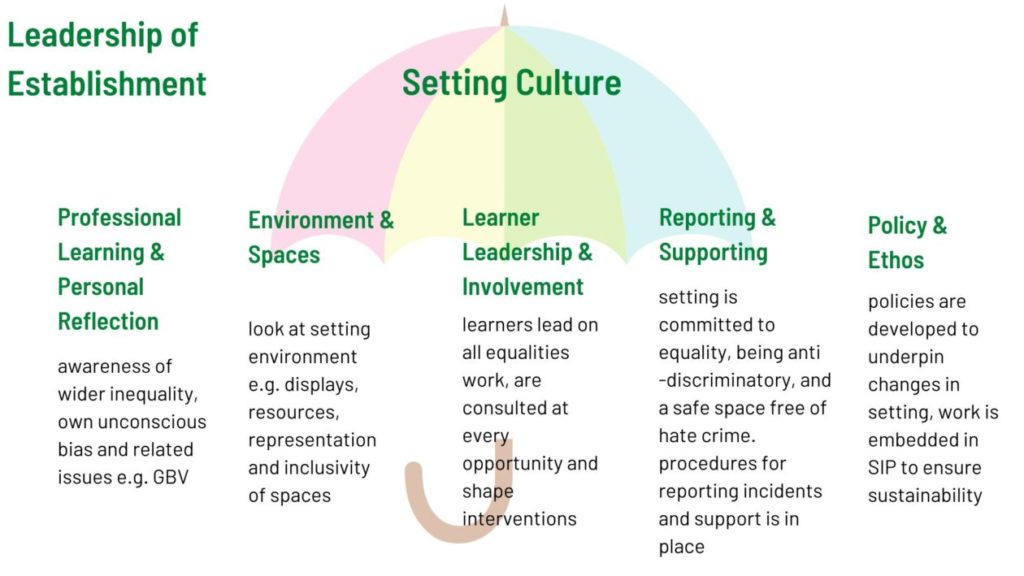PDF file: Data guide for primary schools and early learning and childcare settings – a guide to help practitioners gather and analyse a range of data to support planning approaches to address persistent gender imbalances.
PDF file: Data guide for secondary schools – a guide to help practitioners gather and analyse a range of data to support planning approaches to address persistent gender imbalances.
National Awareness Raising Session – IGBE’s national awareness raising professional learning content
Policy ideas – EqualiTeach Policies & Procedures (scroll down to Policies and Procedures), EqualiTeach Policy Template, Culloden Academy example and IGBE Policy Review Guidance
Equally Safe at School, a whole school approach to preventing gender based violence

Thank you to Darren Donnelly from East Ayrshire for sharing the professional reading he did for Gap Task 1:
1 – The development of educational inequalities during the school years
Education inequalities Review. Inequality: The IFS Deaton Review 16 AUGUST 2022.
“For women studying creative arts or agriculture, the average earnings premium is only around 10%. For men, graduates in some subjects have lower earnings than similar non-graduates. There are also major subject differences in the financial rewards to completing vocational education, with the highest returns in areas such as engineering, business or construction.”
Education inequalities | Inequality: the IFS Deaton Review
2 – Gender gaps and the structure of local labor markets Barbara Petrongolo, Maddalena Ronchib November 2021 From findings in education and post school destinations – important gender gaps still remain to date in employment and earnings. The presence of children is one key driver of remaining gender inequalities – Women appear to especially value job attributes that make careers better compatible with domestic responsibilities, including flexible work schedules and shorter commutes, which may translate into worse earnings opportunities. (Does this explain the curricular choices for careers which are reliable and albeit low income, ‘secure’?) In smaller or rural communities, what opportunities exist for learners avoiding becoming NEET post school?
Gender gaps and the structure of local labor markets – ScienceDirect
3 – Inequalities in education, skills, and incomes in the UK: The implications of the COVID-19 pandemic. June 2021 The Institute for Fiscal Studies ISBN 978-1-80103-027-4 An IFS-Deaton Review of Inequalities initiative funded by the Nuffield Foundation.
(pages 9-12 and 26-29 are especially interesting)
4 – School attendance rates across the UK since full reopening COVID-19 AND EDUCATION AN ANALYSIS
23rd November 2020
Primary and secondary practitioners will be able to relay stories of increased learner anxiety, school refusal and the development of a school/authority ‘phobia’ in certain school communities, Many, increasingly more learners are ‘lost’. How are gender dynamics and gender demographics at play here? Are they centrally recorded? In Scotland, in the second week of November 2020, school attendance rates fell to 89%. Covid-related absences rose to 4%. Further analysis indicates that there is a rise in the number of female students who have developed anxiety/school phobias.
5 – Work, care and gender during the Covid-19 crisis Claudia Hupkau and Barbara Petrongolo Paper Number CEPDP1723 2 October 2020 UK impacts of the pandemic crisis and restrictions to economic activity on paid/ unpaid work for men and women. – Using data from the Covid-19 supplement of Understanding Society… evidence that labour markets of both were roughly equally affected, as measured by incidence of job loss/furloughing, but if anything, women suffered smaller losses at intensive (manual/unskilled) margin, experiencing slightly smaller changes in hours and earnings. (Concentration in low paid employment indicated here!) In households, women provided on average a larger share of increased childcare needs, but in a bigger share of households fathers became primary childcare providers. How will this impact on the perception of young people?
